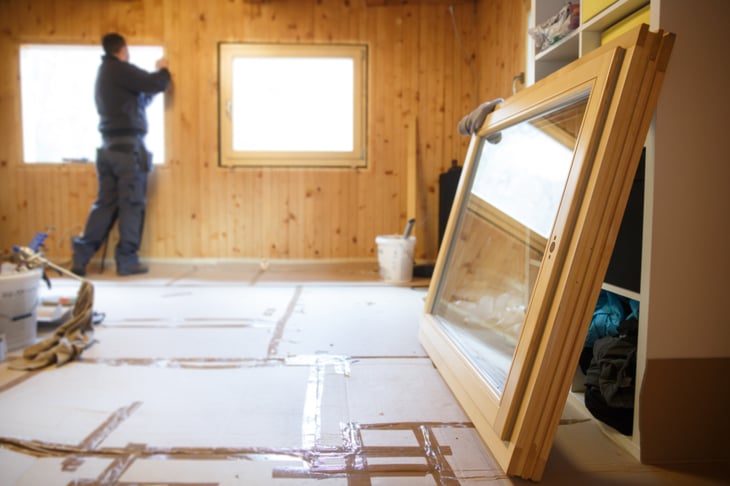
Remodeling or upgrading a home you have rather than shopping for a new one is looking good right now because of very high home prices and interest rates and some markets so competitive that it’s hard to buy a home at all.
But remodeling is rarely a simple proposition, either.
Getting the result you want takes more forethought, planning and attention than you might realize. We asked two pros — Bruce Irving, a renovation consultant and real estate agent and former producer of “This Old House” and affiliated TV shows, and Mallory Micetich, home care expert at Angi — to describe common remodeling mistakes homeowners make and how to avoid them.
The following errors can keep you from getting the results you want or force you to spend much more than you planned — or both.
1. Remodeling too soon

“If it’s not an absolute wreck, I recommend you live in the house for a bit,” says renovation consultant Bruce Irving, who is based in Cambridge, Massachusetts. He’s helped many homeowners with their remodeling and has war stories of his own.
Spend time in the home to see what works, what doesn’t and what you hate and love about the layout, much of which is not apparent at first, Irving tells Money Talks News.
Irving’s tip: During your dreaming and early planning stages, keep a running list of likes and dislikes — features you love about your home and others’, products you admire and also “stuff that sucks” that you’ve seen in some homes.
2. Vague planning

Angi (formerly called Angie’s List) recently surveyed homeowners who’d done major remodeling or renovation in the prior five years. A big 49% confessed regretting that they hadn’t planned more in advance.
Learn from them: Make as many decisions as possible before engaging professionals. That can include choosing products and materials (and backups in case some are unavailable) and planning the dimensions and positioning of the job’s major components.
Failing to think through exactly what you want can force you into making expensive course corrections midway through your project.
Envision everything that can go wrong and plan for it, Angi home care expert Mallory Micetich tells Money Talks News. For example, decide how and how often you will communicate with the general contractor and plan where you can stay if you must move out while work is underway.
3. Ignoring the important stuff

It’s tempting (and understandable) to dream of splashy, magazine-worthy upgrades — the kind of stuff that promises to make life more fun right away.
But your priority should be any problems with your home’s structure, envelope or water management, Irving says.
“Job one is to prevent water infiltration (leaks) in your home so you prevent expensive damage,” he says.
Look for and address leaky or weak areas in the foundation, basement, roof and roof flashings, gutters and downspouts and extensions.
“American homes are mostly built of wood, and wood is mostly killed by water,” Irving says.
4. Deciding to DIY

In Angi’s survey, more than 40% of homeowners who used contractors reported that they felt calm before and during their remodel. That’s compared with just over 20% who took the do-it-yourself route.
Ask yourself frankly, Micetich says: “Do I have the time, the tools and the talent to do this job right?”
Learn more in “6 Times You Should Not DIY a Home Improvement Project.”
5. Seizing the lowest bid

“Don’t ever go for the low bid,” Irving cautions. Likewise, be wary of jumping on the guy or gal who’s available immediately.
Ask yourself why one bid is dramatically lower than the others or one contractor is available when others are booked far out.
Investigate each bidder’s portfolio and references so you come to understand how they estimated your job.
Remodeling professionals are in high demand now. Be prepared to wait for the good ones.
Learn more in “11 Tips for Hiring a Home Improvement Contractor You Can Trust.”
6. Budgeting unrealistically

If you think you’ll be doing your job on the cheap, you’ll probably be forced at some point to get real.
Says Irving: “You are going to be spending more money than you ever thought possible, living with the results for a long time and altering the biggest investment you ever made.” Convincing yourself otherwise invites disappointment, cutting corners or facing costs you can’t afford.
Set aside 10% or more of the total project cost as a buffer, in addition to your budget, to cover any emergencies or surprises that may arise, advises Micetich.
If you don’t have the money for the job you want, consider:
- Should you wait a while?
- Which elements of the job do you really need? Which can be dropped to get the most important things done?
7. Acting as the general contractor

It’s tempting for homeowners to cut out the general contractor. But managing your own project is “a nightmare in the making,” Irving warns.
“A general contractor, they earn that money. Even though people sometimes think, ‘20%? On top of everything?’ But they earn that money easily by coordinating the work and having clout [with subcontractors].”
“Subcontractors respond to contractors’ calls,” he adds. “Homeowners have no pull with any of them.”




Add a Comment
Our Policy: We welcome relevant and respectful comments in order to foster healthy and informative discussions. All other comments may be removed. Comments with links are automatically held for moderation.